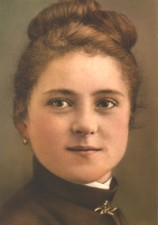Bloom Where You Are
The radical theology of Therese of Lisieux
 By Ma. Ceres Doyo
By Ma. Ceres Doyo
Through her pen the world learned about the story of her soul and her wondrous journey into deep intimacy with God. She did not have a huge following when she was alive for she lived in obscurity in a Carmelite monastery. She did not leave behind large missionary foundations. But through her writing that were made public after she died at the age of 24 in 1897, people got to know her and were amazed at the depth of her spirituality.
Saint Therese of the Child Jesus and the Holy Face, popularly known as Saint Therese of Lisieux or the Little Flower, has arrived in the country. Most Filipinos know her as Santa Teresita. Her relics arrived for a three-month journey across the Philippines and some parts of Asia. The veneration of relics of saints is not idolatry. According to a primer on St. Therese relics, “The veneration must be seen in the way men and women of all ages and cultures venerate the dead and pray in front of her mortal remains. The relics of the saints, meditations of their presence and memorials of their historical existence evoke their humanity – the way they lived, worked, suffered and prayed. Through their relics, God manifest His presence and shows forth His might and glory.” Bishop Ramon Arguelles, Military Vicar and Chair of the millennium Saint Foundation, says that in welcoming Therese’s relics, and her little way of confidence and love, the Church welcomes God’s merciful love. He quotes the Bible, saying: “And a little Child shall lead us.”
Declared by the Catholic Church as the Millennium Saints, Therese was a contemplative who never left the convent during the nine years that she was a nun. Nevertheless, she has been named Patroness of the Missions, side by side the Jesuit missionary Saint Francis Xavier whose incorrupt remains now rest in Goa, India. Although she was not a scholar, Therese (pronounced tey-rez in French) was proclaimed in 1997 the 33rd and youngest Doctor of the Church. She is along with warrior-saint Joan of Arc, co-patroness of France.
 Therese’s written work reveals her to be sugar and steel. A precocious young woman endowed with spiritual gifts and who used them to propel others to great heights. It was through her pen that she shared the workings of God in her young soul. She did not produce huge volumes, just three manuscripts about her life, from childhood until her last days, which was really at first, a family journal and later an account of her spiritual journey, plus some poems. And she wrote only because she had been made to under the rule of obedience.
Therese’s written work reveals her to be sugar and steel. A precocious young woman endowed with spiritual gifts and who used them to propel others to great heights. It was through her pen that she shared the workings of God in her young soul. She did not produce huge volumes, just three manuscripts about her life, from childhood until her last days, which was really at first, a family journal and later an account of her spiritual journey, plus some poems. And she wrote only because she had been made to under the rule of obedience.
Little Way
The essence of Therese’s life and message was spiritual childhood, “the little way”. Born Marie Francoise Therese Martin on January 2, 1873 in Alencon, Normandy, France, she was the youngest of nine children. Her mother died when she was four and it was her father and older sisters who brought her up and doted on her. A headstrong child, she had a bout with a mysterious illness when she was young. The Martin family later moved to Lisieux where Therese was educated by Benedictine nuns. Three of her sisters became Carmelite in Lisieux and another a Visitation nun, Therese entered Carmel in 1888 at the young age of 15 but only after getting a papal dispensation. She made her profession in 1890 and later became mistress of novices.
A Special Soul in their Midst
In 1895 she was made to write the sorry of her soul (Manuscript A and B) by the prioress Mother Agnes who was her own sister (Pauline), and later Manuscript C by another prioress, Mother Marie de Gonzague. Her superior knew that a special soul lived in their midst. But Therese was not a glum, brooding personality. Her novice mistress described her thus: “Tall and robust, childlike, with a tone of voice and expression to match hiding the wisdom, perfection and discernment of a 50-year-old. She is always calm and in perfect possession of herself in all things and with everyone. An innocent little one but her head is full of tricks. A mystic, comic, everything – she knows how to make you weep with devotion or just as easily split your sides with laughter.
Dark Night
During the Holy Week of 1896, Therese discovered she was ill with tuberculosis. This was to be the start of her “dark night” but she continued writing. Therese died in 1897 and was buried in the Lisieux town cemetery where her body lay for many years. Contents of Therese’s notebooks were circulated after she died but only among circle of friends. Little did her sisters know that hey would create a stir and later, “a storm of glory.”
The first manuscripts were published in 1898. They were heavily edited to conform with contemporary style. When Therese’s fame grew, there was a clamor for them ore spontaneous originals. They were published as such upon instruction form the Holy See. The complete, unabridged The Story of a Soul (L’Historie d’ une Ame) as Therese wrote it, became bestseller.
Therese was beatified in 1923 and canonized in 1925 by Pope Pius XI who called her “the star of my pontificate.” Therese’s vision went beyond the monastery walls. She wanted to reach out, “to be a missionary, to proclaim the Gospel on all the five continents.” While in the monastery she corresponded with a young man studying to be a priest. Priests were always the object of her prayers.
Grasping Essence
Many books and scholarly articles have been written about Therese but it is only by reading her simple and original work that one could grasp the essence of the spiritual way that she lived. A sampler: ‘Your love, Jesus, is an ocean with no shore to bound it; and if I plunge into it, I carry with me all the possessions I have. You know, Lord, what those possessions are- the souls you have see in fit to link with mine; nothing else.”
In 1986 a French film based on her life was made, Starring Catherine Mouchet and directed by Alain Cavalier, the film has been positively reviewed as “enormously evocative and powerful.”
Beyond Sweetness
Therese continued writing until her death. And although her writing style could be considered too saccharine, one should be able to see beyond the sweetness. She used a lot of Biblical references and her writings were found to be theologically sound when seen in the context of contemporary theology.
Therese was very much in love and that love was tested during her “dark night”. Her dying words: “I do not die, I enter into life.” The passion and the fire did not dim when the hour of reckoning came. She blazed. She soured.
A Strange Story
By Sr. Amalia Perez ocd
Msgr, James McCloskey, Bishop of Jaro, Iloilo, had an important mission to undertake that picturesque day in 1920 in Lisieux France. As Bishop of Jaro, Iloilo, he was there to request the Mother Patroness of Carmel of Lisieux to help him found a convent of Discalced Carmelite nuns in the Philippines. Having arrived too early for his appointment with Mother Prioress, he found he had time to visit the relics of Therese in the convent’s souvenir room and to pray. When a young nun arrived to give him a tour of the souvenir room, he found himself telling her of his desire to bring Carmel to the Philippines. The nun assured him that Therese of Lisieux would help him and left.
In a while, Msgr. McCloskey was able to see the Mother Prioress, Sr. Agnes of Jesus, who was no other than Marie Pauline, one of the four surviving sister of Therese at that time. Then the Bishop thanked her for having sent the nun to be his tour guide, she expressed some amazement and explained that she had not sent anyone. When the Bishop described the nun, he Mother Prioress exclaimed, “Your Excellency, you have just seen my sister, Therese!”
On November 8, 1923, Mother Teresa of Jesus, Sub-prioress of Carmel of Hue in Annam (now Vietnam). Arrived in Iloilo as Prioress of the new foundation. What Bishop McCloskey loved to point out thereafter was the fact that Carmel of Hue was founded by Carmel of Hanoi, which had been founded by Carmel of Saigon which, if matters are to be traced to the very beginning had been founded by Carmelite nuns from Lisieux in 1861, which is why Carmel in the Philippines traces its origin to Carmel of Lisieux.
St. Therese is known as “the greatest saint” of modern time” because of her Little Way which she explained during one of her last conversations with the Mother Prioress, her own sister, Mother Agnes. “One hope alone,” St. Therese said “makes my heart beat fast. That is the love I shall receive and the love I shall be able to give! I feel that my mission is soon to begin to make others love God as I love Him. To teach souls my Little Way, I will spend my heaven in doing good on earth!”
This is not impossible,” she continued, “for the angels keep watch over us while they enjoy the beatific vision. No, there cannot be any rest for me untilt he end of the world – till the Angel shall have said. Time is no more because the number of the elect will be complete.”
